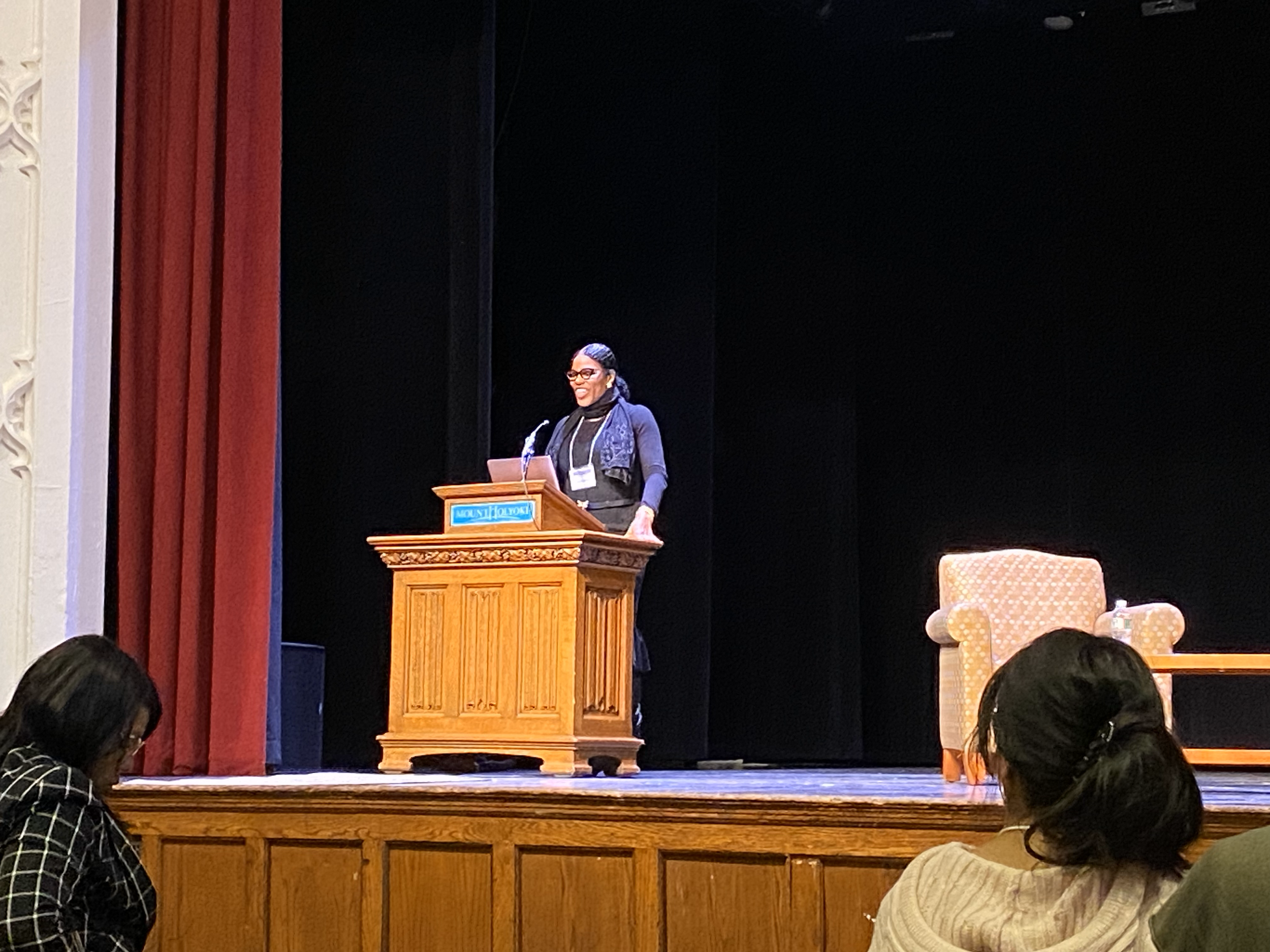By Brie Foster ’27
Staff Writer
The theme of this year’s Trailblazers of Color Leadership Conference was “Looking Back to Look Forward.” According to Mount Holyoke College’s events calendar, the conference aimed to “[mark] a decade of commitment to empowering gender-diverse individuals of color across the Five Colleges, Western Massachusetts, and beyond.”
The conference, which took place on April 6, 2024, celebrated its tenth year while celebrating the accomplishments of gender-diverse people of color and elevating understanding through dialogue.
Photo by Brie Foster ‘27.
Beginning at 9 a.m., the conference consisted of a day filled with workshops, keynotes, and meet and greets and provided attendees with breakfast, lunch, and merchandise, such as tote bags and notebooks.
The conference concluded its long day of events with a highly anticipated public keynote by Ilyasah Shabazz in Chapin Auditorium at 4:30 p.m.
Ahead of the speech, Shabazz was introduced by Sabina Miezah ’24. Shabazz, the third-eldest daughter of Malcolm X and Dr. Betty Shabazz, is an accomplished author, professor, producer, activist, and motivational speaker.
Shabazz began her keynote speech by acknowledging her family, including her father, mother, and five sisters. She then reflected on the 2024 conference theme “Looking Back to Look Forward,” explaining that “it’s only when we know our history that we can chart a path toward the future, and it’s only when we work together for a better future that we honor the foundation that’s been laid by our forefathers and foremothers.”
Before continuing, Shabazz took a moment to thank and praise God and fore-parents “of African ancestry — where our human family traces its foundation.” Shabazz also acknowledged Black and Indigenous individuals whose history and narratives have been “omitted, or rewritten and improperly documented.” In honor of celebrating women’s history, Shabazz also gave praise to the women who came before us. Lastly, Shabazz praised all those who were targeted, impacted, and victimized by slavery and said, “In spite of it all, we are here, still standing, and we prosper.”
In alignment with “Looking Back to Look Forward,” Shabazz’s speech featured a reflection on 19th-century Black abolitionist Charlotte Forten, who was the first African American graduate of Salem Normal School, now Salem State University. Shabazz explained that “despite her positive experience [in school], she remained haunted by the nightmare of racism and sexism.”
In her response to Forten’s story, Shabazz encouraged the audience not to give in to hopelessness. “When we look at this young Black woman … living in the social climate of terror with no laws to protect her humanity, we know there is hope,” Shabazz said. Although Forten sometimes felt that freedom and change would never come, “Look what happened,” Shabazz said, referring to the end of American chattel slavery.
After sharing this exemplary story of change, Shabazz urged the audience to keep hope and faith for better days. “We have to believe that, of course, there will [be change], because we’re willing to do the necessary work to make change.” Shabazz continued.
Shabazz then shifted her focus from Forten to her mother, Dr. Betty Shabazz, after whom Mount Holyoke College named its first cultural center. Like Forten’s story and the story of the Betty Shabazz Cultural Center’s creation, her “mother’s story is one of resilience and faith,” Shabazz said.
After a brief description of her and her sisters’ experience witnessing the assassination of their father, Malcolm X, Shabazz explained that their young mother “never gave in to bitterness or despair.” Rather, her mother worked hard to keep Malcolm X’s legacy alive.
Reflecting on his character, Shabazz spoke of Malcolm X’s fatherly love, curiosity, intelligence, faithfulness to God, and his “moral courage,” which she defined as the ability to “speak truth to power.” Shabazz explained that her father was unafraid because of his humility and faithfulness to God, as well as his moral values. Shabazz also explained that Malcolm X believed that “it is our moral compass that reveals injustice [and] that it is our moral compass that works toward justice.”
Toward the end of her keynote speech, Shabazz once again encouraged the audience to have hope and not to limit themselves, others, or their dreams. Shabazz declared, “Let us become a community of optimists who don’t see the glass half empty, but see the glass half full.”
She concluded her sentiment of defying limitations by also encouraging collective action, arguing that it matters more than individual action. Despite race, class, gender, age, ethnicity, etc., Shabazz encouraged the audience to see past differences and acknowledge their common origins and common challenges with one another.
Following her keynote speech, there was a brief Q&A led by Assistant Curator of Special Projects and Visiting Instructor in Art History and Architectural Studies Kymberly Newberry. When asked, “Do you think conversations in Black liberation are moving forward? How can we as young people learn from the mistakes that the visionary leaders before us made?”
Shabazz replied that intergenerational conversations are important for this so that individuals can learn from one another and find stronger solutions.
The final question for Shabazz: “How can we better combat division between African and African American communities?” Shabazz answered that through education, learning about one another, and recognizing the “truth of our identity as a human family,” we can combat division. Shabazz also noted that not all Black people who were enslaved came from Africa and were indigenous to America, and she further emphasized the importance of “[controlling] the narrative with truth.”
The keynote event ended around 5:45 p.m., and attendees were able to attend a reception with Shabazz afterward.

